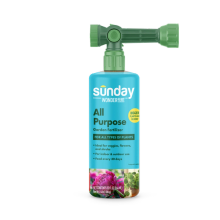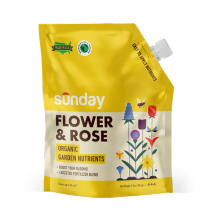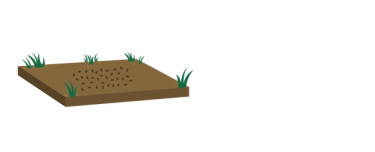Why plant wildflowers?
As if saving pollinators wasn’t enough, mixed wildflower plantings can provide a variety of benefits to your landscape. Here’s a short list of the values they can add:
- Foster biodiversity in the landscape
- Provide critical food resources and overwintering sites for pollinators and other wildlife
- Help build corridors of pollinator and wildlife habitat in urban areas
- After establishment, native plants are relatively low- to no-maintenance
- Smaller carbon footprint: no mowing or fertilization = less fossil fuels used
- Create interest in a landscape by adding a variety of color, texture and fragrance
- Support beneficial insects that can help control harmful turf and insect pests
- Produce cut flowers for bouquets (leaving some for pollinators of course!)
When to plant wildflowers

The best time to plant is in the fall, several weeks after the first frost. The next best time is in spring, several weeks before the last frost. In both cases, the seeds will germinate in spring when temperatures rise.
Some wildflower seeds require stratification before they can germinate (begin to grow). When planting in the fall, this occurs over winter. In the spring, you want to get seeds in the ground early enough for that final frost to snap them into growth mode.
If you live in a temperate climate, you can plant throughout the year, though some seeds planted in summer may not sprout until the following spring.
Sunday Tip:
For cold stratification you can help the seeds along by placing seeds in a refrigerator for a period of time—sometimes 24–28 hours is enough, sometimes seeds need 2–3 months.
Where to plant wildflowers
Wildflowers’ self-sustaining nature makes them a great fit for areas of your yard where your grass might struggle. Whether it’s the back strip where the soil isn’t as good or the edge that the sprinkler misses, wildflowers can usually make it work. Other things to consider:
- Since most wildflowers need sun, avoid planting areas shaded by trees or buildings. South-facing yards receive the most amount of sun, while North-facing receive the least.
- Many annual wildflowers will reseed themselves each year. Some wildflowers are perennial meaning they go dormant in winter and return in spring, just like your grass.
- You can plant additional areas with your new wildflower seed mix or overseed the new mix right into your existing bed! By building up the seed bank with wildflowers, you ensure better competition against weeds and more resilient native beds.
- To prevent wildflowers from taking over, plant at least two feet away from more managed, decorative or landscaped flower beds.
How to plant wildflowers
Planting instructions specific to your flower variety will be included on the seed packet, but here’s a brief run down to help you prepare.
Prep your space
Prepare a space by clearing any existing weeds and vegetation down to the root.

Add fertilizer
If needed, mix plant food or garden fertilizer into topsoil of the cleared area. See the back of your packaging for mix-to-soil ratios.


WonderFert All-Purpose Liquid Garden Fertilizer
- 10-2-6 NPK (Nitrogen-Phosphorus-Potassium) liquid fertilizer for plants
- Ideal for vegetable gardens, outdoor plants, and indoor houseplants
- Water and fertilize all in one step with gentle garden hose-end sprayer
- Multi-use application: hose or watering can
- Slow-release nitrogen sustains plant growth for up to 6 weeks

Flower & Rose Organic Garden Fertilizer
- 4-4-6 NPK
- Ready-to-use
- For outdoor flowering plants
- Organically sourced ingredients
- Feeds your plants for 4–6 weeks
Spread the seeds
Spread seeds evenly across the area, leaving enough space between seeds to see a bit of soil.

Cover seeds
Cover the seeded area with 1/8–1/4 inch of seed starter or top soil.

How to care for wildflowers
Your wildflower seed blend may include both annuals and perennials; some will come up the first year, some will come back, and some may not. Once established, wildflowers can more or less take care of themselves.
In the beginning, though, you’ll need to be a little more hands on—and have a little bit of patience. Here’s what to expect in your first year:
Water
After planting, make sure the area gets well watered either by rain or gently by hand. Keep your soil moist until flowers sprout in about 4-6 weeks, then gradually reduce watering. Avoid overwatering. Planting in the fall? Seeds will remain dormant over winter, so avoid watering until temps start to warm up in spring.
Fertilizer
Optional: After spring germination, reapply plant food mix into the topsoil.
Weeding
Continue to hand-pull weeds as needed from the garden while waiting for the wildflowers germinate and seedlings to emerge from the soil. Hand weed throughout the season, taking care to get all of the roots.
Low maintenance wildflowers
Because they’re native, they have lower water and fertilizer needs and higher resistance to disease. They can even thrive in places where other things struggle to grow! In most areas, spring showers will bring enough precipitation for seeds to sprout, but supplemental water may be needed depending on your local climate.
You can consider adding a thin sprinkle of compost to your wildflower patch in the spring, but many wildflowers will do just fine with no maintenance whatsoever.
Where to get wildflower seeds
At Sunday, we recommend purchasing native perennials as locally sourced as possible. By purchasing locally grown native plants (within ~25-100 miles), you are selecting plants with stronger genetics for your ecoregion, planting native species adapted to your local climate and selecting plants that will be more resilient to unexpected changes in climate (e.g. extreme weather).
You can find wildflower seed packets at your local gardening or hardware store. Be sure to read the sunlight, water, and planting depth and spacing requirements listed on each seed packet to help you pick the best types of wildflowers for your little plot of land.
To find more information on local or regional native plant identification guides, planting resources and native plant suppliers check out your local extension office.
Other ways to support pollinators
In an ever-changing world, pollinators are having a hard time keeping up. New weather patterns, pesticide use, disease, and habitat loss have all contributed to declines in their populations. In addition to planting wildflowers, here are some ways you can help!
- Plant clover in your lawn.
- Let weeds (dandelion, henbit) bloom but not set seed.
- Provide clean, shallow water sources for drinking and bathing.
- Place flat rocks in sunny spaces for butterflies to rest.
- Only use pesticides as a last resort.
- Add additional wildflower seeds or other native plants each year to keep your garden full, beautiful, and strong.
Wildflower FAQs
When should I use the Wildflower Garden Kit?
Seeding and planting live plants, bulbs, and wildflowers can be a one-time or annual practice depending on the species. Proper planting and care will depend on plant type, stratification requirements, and lifecycle.
How do I use this with other Sunday products? Why should I apply in this order?
Treat weeds and prepare new soil/potting mix before seeding and planting. Follow planting with Sunday garden fertilizer, and apply pest control last. Why? This prevents the mixing of weeds into new soil and feeding weeds. Plus, it allows fertilizer to focus on supporting new plant growth and ensures you aren’t washing away pest control when you water your new plantings.
What if I apply out of order?
If you applied fertilizer or pest control before planting, wait at least 24 hours, then plant. If you already planted but didn’t control weeds, hand pull what you can and be careful not to apply weed control to desired plants or seeds.








